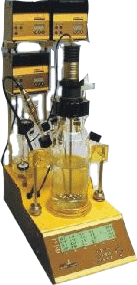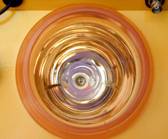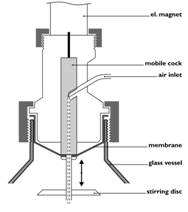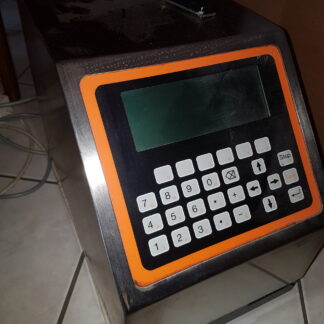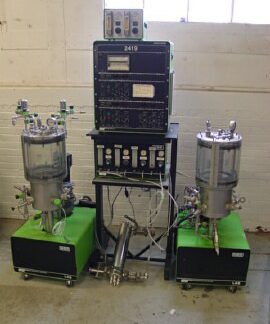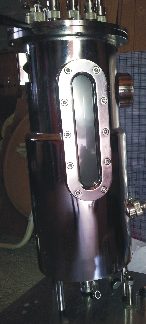Description
Description of the fermentor
The Minifor is a compact laboratory fermentor. Based on long personal practical experience of fermentation the goal was to create a bioreactor, which is easy to use and with the capacity to measure and control all the important parameters of the biological culture. The fermentor had to take up minimum space on the bench but with a good access to all parts. Several fermentors should be placed side by side, for the parameters optimisation for example. Each fermentor should be able to work independently or be connected to a PC for advanced regulation and extensive data treatment. The fermentor can also be used for cells culture. To keep the cost of the MINIFOR fermentor low without compromising quality several new ideas and innovations have been introduced:
- Instead of a vessel with a stainless steel cover, which is expensive, the fermentor uses whole glass vessels with threaded fittings. They have been used for many years in cell culture and are proved to maintain perfect sterility.
- Instead of a traditional propeller agitator, which requires an expensive motor and magnetic coupling, the fermentor uses a new vibration mixer. An electromagnet and an inexpensive membrane which perfectly assure sterility and produce an efficient mixing without formation of a vortex (no baffles are needed). At the same time this type of mixing is more gentle on cells and produces less foam.
- The culture is heated by heat radiation produced in a parabolic radiator with a gold reflector placed under the fermentation vessel. The heat is adsorbed gently in the culture in a similar way to the sun heating water. There is no overheating of the culture, as it is usually the case when a heater is placed in the medium. The expensive double wall vessels with thermostatic baths is eliminated. At the same time pipes and cables disappear making the fermentor less complex.
- As far as possible expensive pieces of equipment have been replaced by new high performance plastics.
- By using modern microprocessors it has been possible to put all the electronics in the front part of the instrument. This makes the fermentor unbelievably compact and eliminates the casing tower usual in other products. Despite its small size six parameters are measured and controlled in the basic configuration of the Minifor.
- Basic unit
The main feature of the Minifor is that all the electronics, power supply, IR heater, air valve, mass flow meter, cables and tubing are positioned in one base unit, which is used as a support for the fermentation vessel and all other necessary equipment. The platform arrangement of the base unit makes all parts of the fermentor clearly visible and easily accessible from all sides despite base dimensions of only 22 × 40 cm (approx. an A4 sheet of paper). Up to five 250 ml reagent bottles in magnetic holders can be placed behind the fermentor vessel and up to 4 pumps can be placed on adjustable holders mounted on bars at the rear part of the base unit. The sockets are located on the rear side of the base unit thus removing cables from the work area.
Fermentation vessel
The standard fermentation vessel has a total volume of 1 litre. Three other vessels are available with a total volume of 0.5 l, 3 liters and 7 liters. The last one is more for cell culture. The vessels are made of high quality Pyrex glass with one large threaded central opening for the fixation of the membrane and vibromixer, and 6 to 8 threaded side necks for the fixation of different sensors, air outlet, sample withdrawal, inoculation etc. Two adjustable holders maintain the vessel in position. The vessel is sterilised in an autoclave.
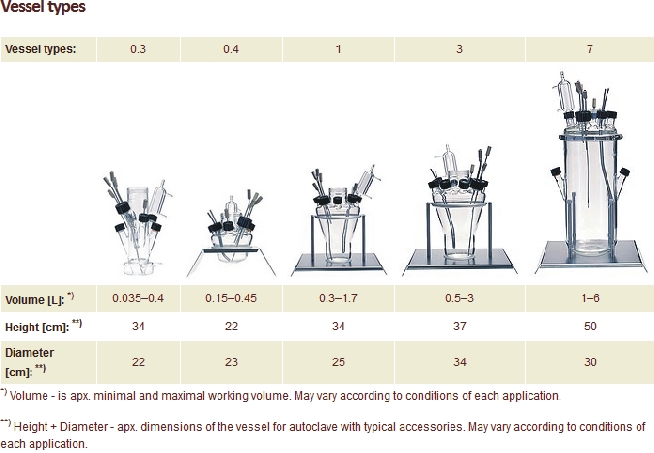
Measurement and regulation
The control panel consists of an LCD display and control buttons. All parameters (temperature, pH, pO2, air flow rate, agitation and one free selectable parameter (for ex. pCO2, optical density, antifoam etc.) are visible at a glance on a large LCD back light display (4 × 40 digits). The controls are simple and logical. On most parameters the limits of low or/and high alarm can be set. After alarm activation an acoustic signal is heard, an indication appears on the display and an electric signal appears on the rear side connector of the fermentor. Each fermentor can be operated in an autonomous way or can be coupled to a PC (over RS 485) using a special fermentation program (SIAM or FNet). This allows almost unlimited possibilities for control and data treatment (up to 6 fermentors in parallel, or more on request).
Agitation
Instead of a traditional propeller agitator a new vibromixer is used in the Minifor. A strong electromagnet moves one or several discs up and down. The major advantage is an efficient mixing and aeration of the culture medium together with very efficient separation of the inside of the vessel from the outside by a low cost silicone membrane. No vortex is built up and baffles are eliminated. This type of agitation is also gentler on the cells and foaming is reduced. The frequency of vibration is controlled by a microprocessor and can be varied through a broad range.The input of air is made through several capillaries fixed under the lowest disc.
Temperature control
A new-patented IR radiator with a gilded parabolic reflector is used to warm the culture broth. The heat radiation (100 W) is concentrated on the bottom of the vessel where it is adsorbed by the medium in a similar way to the sun heating water. There is no overheating of the culture common with heaters placed directly in the medium. Thanks to the low heat capacity of the IR source, overshooting of the temperature is reduced and the temperature can be controlled more precisely. The temperature sensor is placed directly in the pH sensor and is used at the same time for an automatic correction of pH and pO2 electrodes.
pH measurement and control
The pH is measured by a combined, sterilisable pH electrode with incorporated temperature sensor. Thanks to a new multiple plug Variopin it can be sterilised without any protection. The two-point calibration of the electrode is very easy. The addition of acid or base is controlled by a micro-processor. The flow rate of pumps PRECIFLOW, MULTIFLOW or HIFLOW is varied between 0 to 100 %, which makes the pH control smoother than with the common ON/OFF switching of pumps with fixed speed. The unique PUMP FLOW INTEGRATOR (option) when coupled to the pump enables monitoring of the pumps activity during the process. This yields precise kinetic data concerning the culture state and activity.
The pH can also be controled with CO2, specially for cells culture. A special gas flow controller has been developped for such applications.
pO2 measurement and regulation
A sterilisable Clark-type electrode measures the concentration of dissolved oxygen with a special reinforced membrane giving fast response times. The microprocessor performs two-point calibration and automatic temperature correction. The regulation of dissolved oxygen is obtained by a variation of the flow rate of air.
Air input
The flow rate can be set from 0 to 5 l/min. in 0.1 steps. A precise mass-flow meter is used. This measurement is independent of the pressure and temperature variation of the air. Commonly used floating ball capillaries give inaccurate readings in this case. A proportional air valve using memory metals adjusts the flow rate.
Air output
Used air is filtered by a PTFE filter. If necessary an optional condenser can be used to remove water vapour from the stream. The condenser based on a Peltier cell uses no cooling water.
Inoculation and sampling ports
Inoculation, addition of acid or base and sample removal is made through four stainless steel capillaries equipped with Luer-Lock adapters.
Sterilisation
The fermentation vessel is sterilized as usual in an autoclave after disconnection of the cables from the electrodes and electromagnet.
Antifoam
A foam detection device is available to add an antifoam agent into the fermentor with a peristaltic pump or a syringe pump.
Redox potential measurement
With an additional electronic box connected to the fermentor it is possible to measure the redox potential (-999 to 999 mV) of the solution. The electrode can be sterilised.
Continuous culture
The weight of fermentor can be kept constant by using a special weighing module placed under the front edge. The harvesting pump will keep automatically the volume of the culture constant. Continuous cultures allow a considerable increase of productivity.
Dimensions
A lot of effort was made to make the Minifor as small and as compact as possible.The platform arrangement of the fermentor makes control and access to all parts easy from all sides.The distance between the reagent bottles, pumps placed above them and the fermentor vessel is the shortest possible.
Pumps
Up to four pumps PRECIFLOW, MULTIFLOW or HIFLOW can be placed on holders fixed on two bars at the rear of the fermentor. They are connected by a single cable to the sockets on the rear side of the fermentor. Since the pumps are not bound to the fermentor they can be used for other applications elsewhere in the laboratory (for ex. for chromatography etc.). This can present a considerable economy for the user.
Technical parameters
Minifor is controlled by two microprocessors
| Power | mains 190-245 V AC/50-60 Hz CE conform (other voltages on request) |
| Dimensions | 22 × 40 × 38 cm (W × D × H) |
| Display | LDC 4 × 40 digits with backlight |
| Fermentor vessel | Pyrex glass with 5 to 8 side necks 0.5, 1 l, 3 l (other volumes on request) |
| Temperature control | special radiation heat source with gilded reflector 100 W, |
|
from 5 °C over RT to 70 °C |
|
from 0 to 99.9 °C in 0.1 °C steps |
|
± 0.2°C (0 to 60°C) |
|
Pt 100 incorporated in the pH sensor |
| pH control | sterilizable pH electrode pH 0 to13, with automatic temperature correction, Variopin connector, two-point semiautomatic calibration |
|
0.01 pH unit |
|
± 0.02 pH unit |
| pO2 control | sterilisable Clark type oxygen sensor with fast response and reinforced Teflon membrane, regulation through airflow rate |
|
0 to 10 mg oxygen/l, in 0.1 mg/l steps |
| Air Flow | 0 to 5 l/min. in 0.1 l/min. steps, mass flow meter, linearity ± 3 %, reproducibility ± 0.5 % |
|
proportional valve using memory metals |
|
between 0.05 and 0.2 MPa |
| Agitation | 40 W vibromixer 0 to 20 Hz with 1 or more stirring discs, sterility similar to magnetic coupling |
| Selectable parameter | an additional parameter can be controlled by the instrument (foaming control, pCO2, optical density, conductivity, etc.) |
| Redox potential measurement | -999 to 999 mV |
| Sampling ports | up to four needles with Luer-Lock fittings can be used for sampling and addition of correction solutions |
| Pumps | up to 4 independent pumps with speed variation from 0 to 100 % can be used with Minifor (PRECIFLOW, MULTIFLOW or HiFLOW) |
| Working temperature | 0-40 °C |
| Working relative humidity | 0-90 % |
| Weight | 7.5 kg |
| PC control | complete PC control and date treatment using SIAM fermentation software or FNet |
The Minifor is the ideal fermentor for quality by design (QbD), design of experiment (DOE) and for screening.
